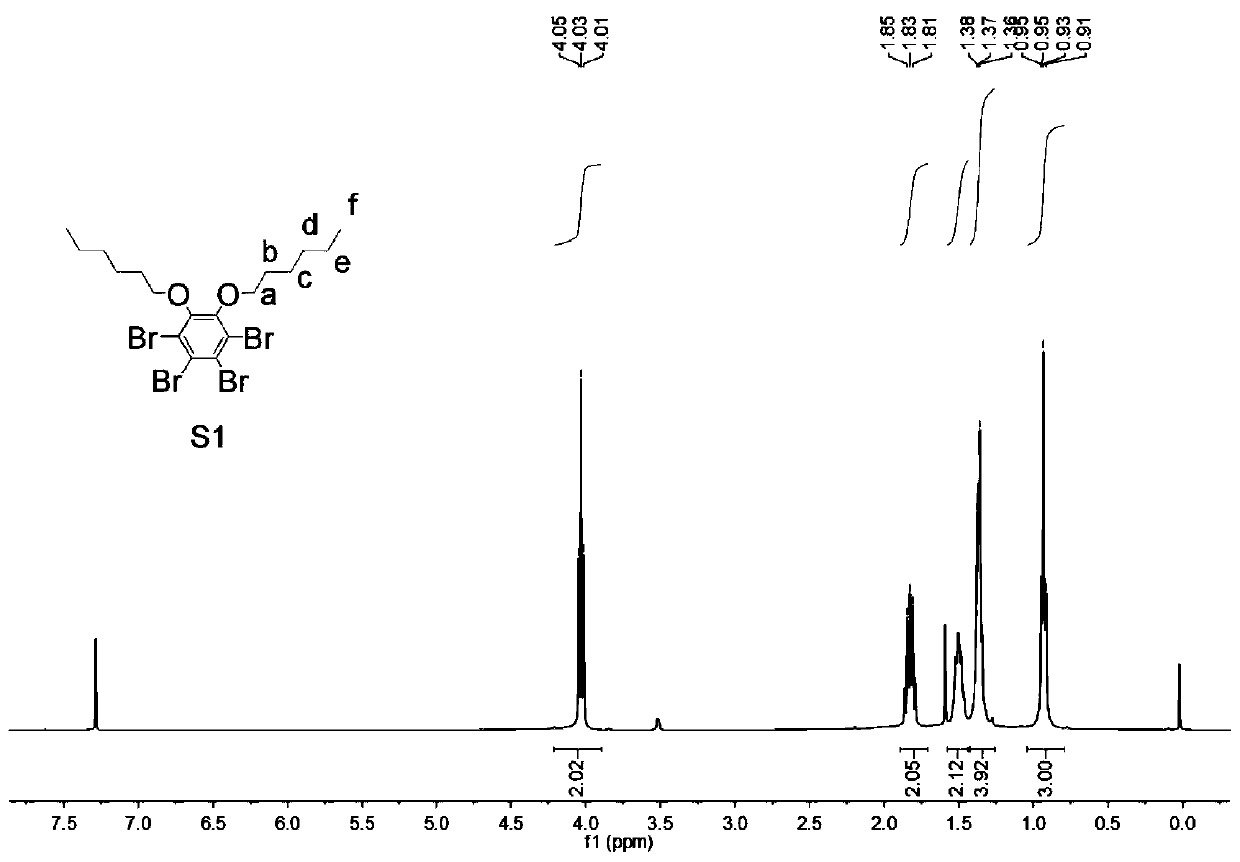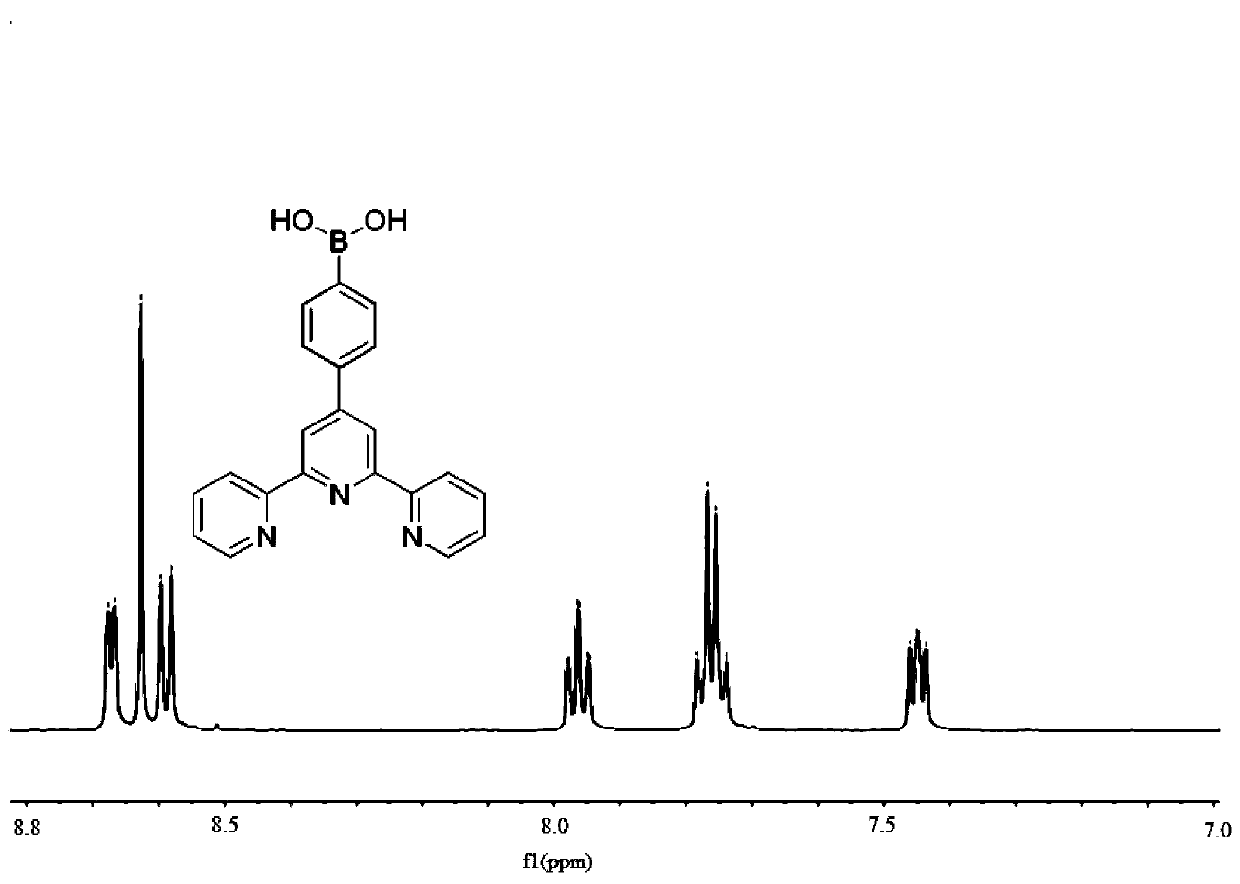A strip-shaped single-layer metal-organic polymer sheet and its preparation method
A metal-organic and polymer technology, applied in the field of new supramolecular material synthesis, can solve problems such as unstable properties and poor optoelectronic properties, and achieve the effect of high electron density, large conjugated structure, and wide potential research value.
- Summary
- Abstract
- Description
- Claims
- Application Information
AI Technical Summary
Problems solved by technology
Method used
Image
Examples
Embodiment 1
[0058] 1,2,3,4-Tetrabromo-5,6-di-n-hexaneoxybenzene (Intermediate 1):
[0059]
[0060] 1,2,3,4-tetrabromophenyl-5,6-diol (4.25g, 10mmol), 1-bromo-n-hexane (3.6g, 22mmol), potassium carbonate (3g, 24mmol) and DMF (100mL) Add them together into a 250mL three-neck round bottom flask, then heat and stir at 100°C for 24 hours under nitrogen protection, cool to room temperature, then distill off the solvent under reduced pressure, add the residue to n-hexane and sonicate, filter, and distill the filtrate under reduced pressure , the residue was recrystallized several times with methanol, and after drying, 3.6 g of side chain-substituted polybrominated aromatic hydrocarbons were obtained, with a yield of 61%. NMR 1 H is pictured as figure 1 As shown, the NMR data are: 1 H NMR (400MHz, CDCl 3 )δ4.03(t, J=6.7Hz, OCH 2 R, Alkyl a ,4H),1.83(m,Alkyl b ,4H),1.50(m,Alkyl c 4H), 1.36(td, J=7.0, 3.4Hz, Alkyl d,e 8H), 0.94(dd, J=9.5, 4.5Hz, Alkyl f 6H).13C NMR (125MHz, CDCl 3...
Embodiment 2
[0071] Morphological analysis of metal organic polymers:
[0072] Transmission electron microscopy (TEM) is a test method that can directly observe the microscopic morphology, and the polymer is observed using the transmission electron microscope. Dissolve the polymer in acetonitrile solvent, and ultrasonically disperse it evenly (concentration is 10 -6 mol / L), using an ultra-thin carbon support film as a substrate, an image such as Figure 5 , the morphology of a series of uniformly dispersed ribbon-shaped metal-organic polymer flakes with a diameter of about 10 nm is consistent with the size of the simulated molecular structure.
[0073] Scanning electron microscopy (SEM) mainly uses secondary electron signal imaging to observe the surface morphology of samples, and has the characteristics of direct observation of larger samples, wide magnification range and large depth of field. The powder sample was fixed with conductive glue, and the surface morphology of the polymer wa...
Embodiment 3
[0076] Spectral analysis of metal organic polymers:
[0077] The spectrum absorption of the conjugated polymer material of the present invention adopts a cuvette with an absorption layer of 1 cm, and is analyzed and tested by an ultraviolet-visible absorption spectrometer, thereby judging the MLCT (charge from metal to metal) in ligand conjugation and ligand coordination. ligand transfer). The absorption spectrum of the polymer in acetonitrile solution is as Figure 7 shown.
[0078] Figure 7 It can be seen that the "K" type terpyridine complex and the metal-containing Zn 2+ and Cd 2+ The UV absorption spectra of the three ionic metal organic polymers. All three have broad absorption peaks around 280nm, which is the conjugated absorption peak of terpyridine. In addition, organometallic polymers containing metal Zn and Cd ions have a new UV absorption peak at 340nm and 325nm, which is tpy-M 2+ -tpy absorption peak. This shows that the organic ligand containing terpyrid...
PUM
 Login to View More
Login to View More Abstract
Description
Claims
Application Information
 Login to View More
Login to View More - R&D
- Intellectual Property
- Life Sciences
- Materials
- Tech Scout
- Unparalleled Data Quality
- Higher Quality Content
- 60% Fewer Hallucinations
Browse by: Latest US Patents, China's latest patents, Technical Efficacy Thesaurus, Application Domain, Technology Topic, Popular Technical Reports.
© 2025 PatSnap. All rights reserved.Legal|Privacy policy|Modern Slavery Act Transparency Statement|Sitemap|About US| Contact US: help@patsnap.com



